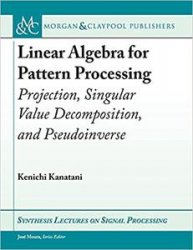 Название: Linear Algebra for Pattern Processing: Projection, Singular Value Decomposition, and Pseudoinverse
Название: Linear Algebra for Pattern Processing: Projection, Singular Value Decomposition, and PseudoinverseАвтор: Kenichi Kanatani
Издательство: Morgan and Claypool
Год: 2021
Формат: PDF
Страниц: 155
Размер: 10 Mb
Язык: English
Linear algebra is one of the most basic foundations of a wide range of scientific domains, and most textbooks of linear algebra are written by mathematicians. However, this book is specifically intended to students and researchers of pattern information processing, analyzing signals such as images and exploring computer vision and computer graphics applications. The author himself is a researcher of this domain.
Such pattern information processing deals with a large amount of data, which are represented by high-dimensional vectors and matrices. There, the role of linear algebra is not merely numerical computation of large-scale vectors and matrices. In fact, data processing is usually accompanied with "geometric interpretation." For example, we can think of one data set being "orthogonal" to another and define a "distance" between them or invoke geometric relationships such as "projecting" some data onto some space. Such geometric concepts not only help us mentally visualize abstract high-dimensional spaces in intuitive terms but also lead us to find what kind of processing is appropriate for what kind of goals.
First, we take up the concept of "projection" of linear spaces and describe "spectral decomposition," "singular value decomposition," and "pseudoinverse" in terms of projection. As their applications, we discuss least-squares solutions of simultaneous linear equations and covariance matrices of probability distributions of vector random variables that are not necessarily positive definite. We also discuss fitting subspaces to point data and factorizing matrices in high dimensions in relation to motion image analysis. Finally, we introduce a computer vision application of reconstructing the 3D location of a point from three camera views to illustrate the role of linear algebra in dealing with data with noise. This book is expected to help students and researchers of pattern information processing deepen the geometric understanding of linear algebra.